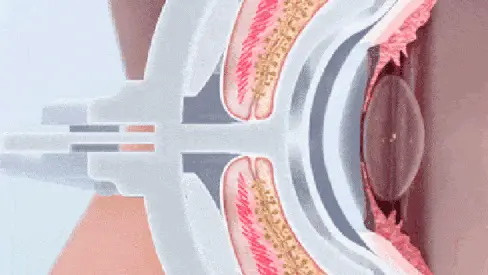References:
1. M. A. Lemp, L. Bardfield, C.A. Blackie, H. P. Saras, S. Grenon, J Hutchinson, B Gravely,T. Douglass, D. R. Korb; Evaluation of a Novel Method of Treatment of Dry Eye. Invest.
2. "Information based on internal competitive data and patent analysis as of June 2018 against TearScience and iLux Systems in the US. See iLux website http://www.tearfilm.com/ilux-device/ and TearCare website https://tearcare.com
3. Lemp MA, et al. Distribution of Aqueous-Deficient and Evaporative Dry Eye in a Clinic-Based Patient Cohort. Cornea. 2012; 31(5): 472-478. doi:10.1097/ co.0b013e318225415a.
4. Viso E, et al. Prevalence of asymptomatic and symptomatic Meibomian Gland Dysfunction in the general population of Spain. Invest Ophthalmol Vis Sci. 2012; 53(6): 2601–2606. doi: 10.1167/ iovs.11-9228
5. Blackie CA, Coleman CA, Holland EJ. The sustained effect (12 months) of a single-dose vectored thermal pulsation procedure for meibomian gland dysfunction and evaporative dry eye. Clin Ophthalmol. 2016; 10: 1385-1396.
6. Lane SS et al. A New System, the LipiFlow™, for the Treatment of Meibomian Gland Dysfunction (MGD). Cornea. 2012;31(4):396-404.
7. Blackie C, Carlson AN, Korb DR. Treatment for meibomian gland dysfunction and dry eye symptoms with a single-dose vectored thermal pulsation: a review. Current Opinion in Ophthalmology. 2015; 26(4):306 13.
SUMMARY OF IMPORTANT SAFETY INFORMATION
Rx Only
FOR THE TEARSCIENCE™ LIPIFLOW™ THERMAL PULSATION SYSTEM
INDICATIONS FOR USE
The TearScience LipiFlow System is intended for the application of localized heat and pressure therapy in adult patients with chronic cystic conditions of the eyelids, including Meibomian Gland Dysfunction (MGD), also known as Evaporative Dry Eye or Lipid Deficiency Dry Eye.
CONTRAINDICATIONS
Do not use the TearScience LipiFlow System in patients with the following conditions. Use of the device in patients with these conditions may cause injury. Safety and effectiveness of the device have not been studied in patients with these conditions.
Ocular surgery within prior 3 months, including intraocular, oculo-plastic, corneal or refractive surgery procedure
Ocular injury within prior 3 months
Ocular herpes of eye or eyelid within prior 3 months
Active ocular infection (e.g., viral, bacterial, mycobacterial, protozoan, or fungal infection of the cornea, conjunctiva, lacrimal gland, lacrimal sac, or eyelids including a hordeolum or stye) Active ocular inflammation or history of chronic, recurrent ocular inflammation within prior 3 months (e.g., retinitis, macular inflammation, choroiditis, uveitis, iritis, scleritis, episcleritis, keratitis)
Eyelid abnormalities that affect lid function (e.g., entropion, ectropion, tumor, edema, blepharospasm, lagophthalmos, severe trichiasis, severe ptosis)
Ocular surface abnormality that may compromise corneal integrity (e.g., prior chemical burn, recurrent corneal erosion, corneal epithelial defect, Grade 3 corneal fluorescein staining, or map dot fingerprint dystrophy)
PRECAUTIONS
The TearScience™ Activator (Disposable) may not fit all eyes, such as eyes with small palpebral fornices. Use of the TearScience LipiFlow System in patients with the following conditions may result in reduced treatment effectiveness because these conditions may cause ocular symptoms unrelated to cystic meibomian glands and require other medical management. Safety and effectiveness of the device have not been studied in patients with these conditions.
Moderate to severe (Grade 2-4) allergic, vernal or giant papillary conjunctivitis
Severe (Grade 3 or 4) eyelid inflammation (e.g., blepharochalasis, staphylococcal blepharitis or seborrheic blepharitis). Patients with severe eyelid inflammation should be treated medically prior to device use
Systemic disease conditions that cause dry eye (e.g., Stevens-Johnson syndrome, vitamin A deficiency, rheumatoid arthritis, Wegener’s granulomatosis, sarcoidosis, leukemia, Riley-Day syndrome, systemic lupus erythematosus, Sjögren's syndrome)
Taking medications known to cause dryness (e.g., isotretinoin (Accutane®) and systemic antihistamines)
Esthetic eyelid and eyelash procedures (e.g., blepharoplasty, lash extensions, eyelid tattooing) In addition, the treatment procedure may loosen previously inserted punctal plugs, which may worsen the patient’s dry eye symptoms.
ADVERSE EFFECTS
Potential adverse effects that may occur as a result of the procedure include, but are not limited to, the onset or increase in
Eyelid/eye pain requiring discontinuation of the treatment procedure
Eyelid irritation or inflammation (e.g., edema, bruising, blood blister, dermatitis, hordeolum or chalazion)
Ocular surface irritation or inflammation (e.g., corneal abrasion, conjunctival edema or conjunctival injection (hyperemia)
Ocular symptoms (e.g., burning, stinging, tearing, itching, discharge, redness, foreign body sensation, visual disturbance, sensitivity to light)
Potential serious adverse events (defined as permanent impairment or damage to a body structure or function or necessitates medical or surgical intervention to preclude permanent impairment or damage to a body structure or function) that are not anticipated because of the device mitigations to prevent occurrence include:
Thermal injury to the eyelid or eye, including conjunctiva, cornea or lens
Physical pressure-induced injury to the eyelid
Ocular surface (corneal) infection
PP2023OTH5148
